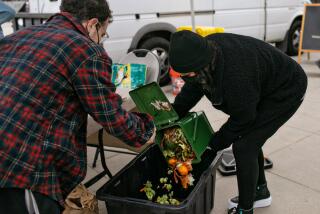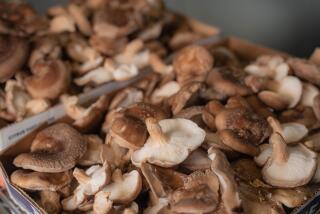GARDENING : Open a Can of Worms to Get Rich Fertilizer
- Share via
If you’re looking for a quick, easy way to compost kitchen and yard waste, worms may be your answer. Raising worms to produce compost is a simple process known as vermicomposting that leads to rich, ready-to-use fertilizer.
“The worms recycle for you,” says Patrick McNelly, senior administrative assistant with the Sanitation Districts of Orange County. “They eat decaying food and vegetation and excrete rich compost.”
Worm excretions, otherwise known as castings, are what Richard Morhar calls “nature’s perfect plant food.” Plants grown in castings produce superior vegetables, fruit and vegetation.
Morhar is founder of the Worm Concern, a worm farm in Thousand Oaks that has produced a variety of worm-related products for homeowners and landscapers since 1976.
“Worm castings produce time-release minerals that are assimilated by plant root systems as they need it, not all at once like chemical additives,” Morhar says. “Castings are a complete food perfect for plants.”
Vermicomposting enables you to easily recycle kitchen and yard waste.
“A pound of worms eat about a pound of garbage a day,” Morhar says. “In a worm box, the worms eat the garbage you put on top, then go down to the bottom of the box to excrete castings. Every month or so you remove the castings.”
The process is similar to feeding hay to horses, which then produce manure, but worm compost is practically odorless.
Setting up a worm farm is easy. To get started, you need a container.
“Any kind works,” says McNelly, who has raised worms for 17 years. “You can use a 55-gallon drum or a 5-gallon wash bucket.”
Scrub the container before using it, and avoid placing worms in anything that has stored chemicals, which can be harmful to the worms.
When choosing a bin, it’s best to opt a shallow one.
“The length and width of the bin don’t make a difference,” says Morhar, who sells worm boxes of various proportions. “The box height is important, though. It should be no higher than 16 to 18 inches, because worms are surface eaters and won’t work a whole box if it is very deep.”
A deep box may also have an odor.
A 1-by-2-by-3-foot box produces about 10 gallons of worm castings a month and is good for a household of four to six people, Morhar says.
If you make a wooden box, include drainage holes on the bottom and don’t use highly aromatic woods, such as redwood and cedar, because they can harm the worms.
Once your bin is ready, fill it halfway with bedding material, such as shredded newspaper, shredded cardboard, leaf mold, peat moss (although this has a tendency to be too acidy), or horse or rabbit manure. You can combine bedding materials.
“I use shredded paper and compost that isn’t hot anymore, and it works really well,” says Eunice Messner, who is a member of the Orange County chapter of the Rare Fruit Growers.
“Wet down the bedding for a week to make sure the contaminants are leached out and the fibers are thoroughly wet,” Morhar says. This also will ensure that any manure is not too hot, which could kill the worms.
The next step is to add about 1,000 red worms, which should eat a pound of garbage a day. Red worms can be purchased through mail order companies found in organic gardening magazines, from bait farms or through the Worm Concern in Thousand Oaks. Worms ship well in the mail and can be refrigerated for several days after they arrive.
Place the worms on top of the bedding in the sunshine. Since they do not like light, the worms should burrow down into the soil within five minutes. If there are any worms left on the surface an hour later, discard them.
“Worms prefer foods that are small, soft and wet and don’t do as well with things that are tough and hard,” Morhar says.
Feed worms vegetable cuttings, coffee grounds, rotten avocados, peaches, grapes, tomatoes, apples, cream of wheat, baked beans, pie, cake, lettuce, molasses, cornmeal, tortilla flour, tea leaves, mashed potatoes, cereal, pancakes, cream cheese, potato salad, deviled eggs, crushed eggshells. But don’t give the worms meat and bones, or any foods that are hard and fibrous.
Keep the bin moist at all times because worms breath through the skin, which must be wet. Place the bin in the shade so it doesn’t dry out and cover it.
Harvest worm castings each month by placing food in the bin the day before to lure the worms to the top to eat. Then take the top half off, placing it in buckets and remove the bottom half, which is castings. Put the top half back in the box and new food on top. If the bedding is low, you may also wish to add more. McNelly removes castings and replaces the bedding every three months.
If a worm bin is well taken care of, the worms will multiply and you can even expand into another bin if you choose. McNelly hasn’t bought any worms since his first batch 17 years ago.
After you remove your castings, blend with potting mix, till it into garden beds before planting, use it as a top dressing, and start seedlings in it.
For more information, consult the book “Worms Eat My Garbage,” by Mary Appelhof. (Flower Press, Kalamazoo, Mich . 1982).






